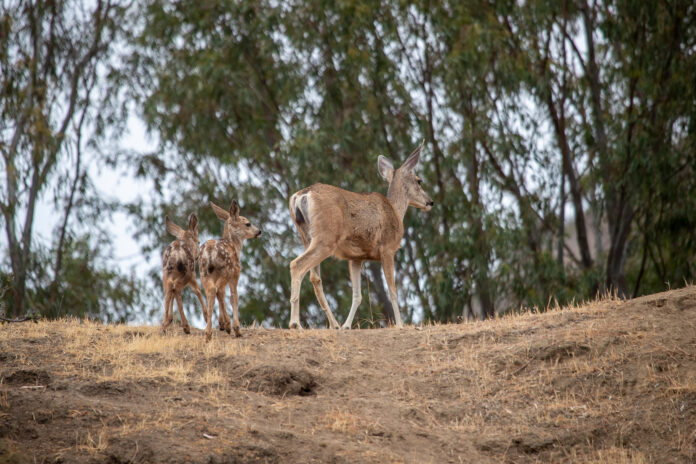FILE: A deer and its calves on Catalina Island in June 2021.
Allen J. Schaben/Los Angeles Times/Getty ImagesSanta Catalina Island officials have devised a unique plan to manage an invasive species.
The Catalina Island Conservancy, the nonprofit in charge of protecting the island, plans to kill the nearly 2,000 mule deer using helicopter sharpshooters, according to the Los Angeles Times. The mule deer will be shot with leadless bullets so as not to poison any scavengers who find the carcasses.
Advertisement
Article continues below this ad
Advertisement
Article continues below this ad
The decision outraged members of the public. “We are completely against the slaughter of innocent mule deer on Catalina Island,” Dianne Stone, vice president of the Catalina Island Humane Society, told the LA Times. “The Conservancy’s solution is violent and ugly.”
In a statement, the Catalina Island Conservancy said the culling plan is necessary “to alleviate the detrimental impact of these species on native plants and animals and restore ecological balance.”
Humans introduced mule deer to Catalina Island in the 1920s and 1930s for hunting, according to the Catalina Islander. However, the island is overpopulated with the species because the mule deer has no natural predators on the island.
The Catalina Island Conservancy said the deer is responsible for destroying many of the island’s plants, which native species such as the Catalina Island fox, ground squirrel and shrew rely on for food.
The California Department of Fish and Wildlife manages the deer on the island, and a spokesperson told the LA Times that the agency was “supportive of the habitat restoration project.”
A look at Catalina Island off the coast of Los Angeles in California.
Matthew Micah Wright/Getty ImagesA backlash to the proposal has begun as members of the public plead with the CDFW to intervene. On Sept. 23, a petition began circulating questioning the “scientific integrity, cultural relativity, humane considerations,” and the “legal rights as citizens of California to be a greater part of the process.”
Advertisement
Article continues below this ad
The petition has garnered almost 5,000 signatures from across the state.
“THIS IS THEIR HOME AS MUCH AS IT IS OURS!! ” wrote Cassandra Castellanos from Redlands, California. “The mule deer are a staple for catalina island. I grew up seeing them, feeding them, and admiring them. They are beautiful, innocent creatures that deserve to live as much as we do.”
This is not the first attempt from the conservancy to rein in the mule deer population. In 2014, the nonprofit stipulated that more does than bucks were to be hunted to help limit birthrates.
Catalina has had several invasive species introduced to the island, including domestic goats, bison and feral pigs to root out rattlesnakes. The conservancy introduced a similar program using sharpshooters that successfully eradicated the invasive goat population in the 1990s. Some locals who signed the petition said they don’t wish to see a repeat of this and that the program was “inhumane.”
“The slaughter of these beautiful gentle creatures is horrific and cruel,” Brenda Carel, a resident of Avalon, the only incorporated city on Santa Catalina Island, wrote in the petition. “The visual images of them shooting them from helicopters and letting their carcasses lay there to rot like they did the goats is not something I care to see again!”
The Bay Area has a history of mitigating invasive species using lethal force, including a similar issue with a nonnative deer population in Marin County.
In 2006, authorities for the Point Reyes National Seashore introduced both culling and contraceptives measures to mitigate the axis and fallow deer, two nonnative deer species. The meat, carcasses and hides went to food banks, Indigenous tribes and others.
“The program was successful in removing nonnative axis and fallow deer from Point Reyes National Seashore,” a National Park Service spokesperson told SFGATE.
The conservancy does not plan to airlift the carcasses because it would be too expensive, according to the LA Times. However, they do plan to move them from roadsides and away from Avalon.
Advertisement
Article continues below this ad
Advertisement
Article continues below this ad



